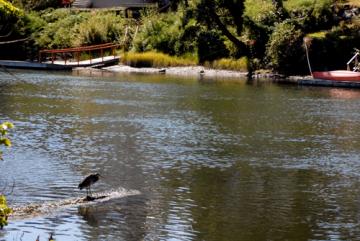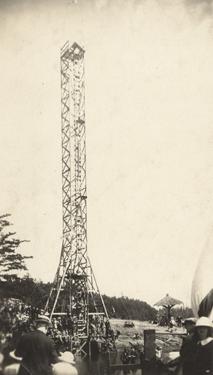
“It’s too polluted”—that’s the reason most people will give you for not wanting to swim in the Gorge Waterway. But is it really true? The answer to that question is somewhat controversial. Some people worry about chemical contamination—that run-off and industrial activities around the Gorge have affected the water quality, posing a risk to humans. But many say the Gorge is actually one of the cleaner bodies of water the community can enjoy swimming in. Indeed, fecal cloriform counts in the Gorge, taken regularly by Vancouver Island Health Authority (VIHA), are much lower than other popular swimming spots in the Capital Region. Readings from early July 2013 put Esquimalt-Gorge Park at 11 counts per 100 mL of water when Thetis Lake was at 110 counts. Since 1994, various efforts to clean the Gorge Waterway, and the streams that empty into it, gained strong momentum with visible results. So why not jump in?
 It’s worth remembering that the Gorge was once a vibrant swimming spot for the Greater Victoria community. From the 1890's to the 1930's, the Gorge Waterway was a place for swimming schools and competitive swimming for national titles. The Gorge was regarded as Victoria’s swimming resort, and swimming galas held on the Gorge attracted international swimming stars. Following a diving accident in 1922 and the opening of Crystal Pool in 1926, swimming galas stopped being organized on the Gorge. Finally, in 1939 swimming in the Gorge was banned due to sewage and industrial waste. Bans on swimming in the Gorge have been lifted and reinstated several times since.
It’s worth remembering that the Gorge was once a vibrant swimming spot for the Greater Victoria community. From the 1890's to the 1930's, the Gorge Waterway was a place for swimming schools and competitive swimming for national titles. The Gorge was regarded as Victoria’s swimming resort, and swimming galas held on the Gorge attracted international swimming stars. Following a diving accident in 1922 and the opening of Crystal Pool in 1926, swimming galas stopped being organized on the Gorge. Finally, in 1939 swimming in the Gorge was banned due to sewage and industrial waste. Bans on swimming in the Gorge have been lifted and reinstated several times since.
The Gorge receives fresh water drainage from much of the CRD region. In fact, the watersheds that drain into the Gorge cover an area of 81.6 km, stretching from Elk Lake in the north, PKOLS (Mount Douglas) in the east and the highlands in the west. That’s a long way for the water to go before emptying into the Waterway, so the question is, is it clean once it gets there? As already mentioned, in terms of fecal coliform, VIHA is responsible for monitoring the water quality at local beaches and posts, including regular sampling at Craigflower Bridge beach (Kasapsom Park), Esquimalt-Gorge Park, Curtis Point, and Banfield Park dock, and the values at the Gorge are comparable and often lower than freshwater beaches in the region, without the peaks in fecal cloriform counts see in other locations. But what about industrial activity and automobiles?
 Heavy metals and other metallic compounds present in the Gorge are indicators of industrial activity and automobiles. Run-off, which picks up metal compounds, oils, and gasoline on the way to the Gorge, is a potential concern. However, according to Joachim Carolsfeld at World Fisheries Trust, none of these compounds have been observed in significant levels in the Gorge in most recent data—both in the water and the sediments.
Heavy metals and other metallic compounds present in the Gorge are indicators of industrial activity and automobiles. Run-off, which picks up metal compounds, oils, and gasoline on the way to the Gorge, is a potential concern. However, according to Joachim Carolsfeld at World Fisheries Trust, none of these compounds have been observed in significant levels in the Gorge in most recent data—both in the water and the sediments.
In terms of pesticides and other contaminates, Carolsfeld points out that there is currently no monitoring for this going on. However, Saanich owns much of the waterfront and creekside land on the Colquitz drainage area (Colquitz is one of the major streams that drains into the Portage Inlet and then the Gorge) and they have a pesticide- and herbicide-free policy. Furthermore, sensitive marine life, such as bubbleshells, are not showing the effects you would expect from pesticides and herbicides.
 The annual Gorge Swimfest helps remove the pollution stigma that surrounds the Gorge Waterway while also reconnecting residents to the significant waterway that runs through their community. The Gorge Waterway Initiative (GWI) is a collaborative community-run group of organizations committed to protecting and enhancing the natural and cultural features of the Gorge Waterway. The GWI and its partnering groups are a great place for resources that will help you decide whether you should "be afraid" of swimming in the Gorge Waterway or not.
The annual Gorge Swimfest helps remove the pollution stigma that surrounds the Gorge Waterway while also reconnecting residents to the significant waterway that runs through their community. The Gorge Waterway Initiative (GWI) is a collaborative community-run group of organizations committed to protecting and enhancing the natural and cultural features of the Gorge Waterway. The GWI and its partnering groups are a great place for resources that will help you decide whether you should "be afraid" of swimming in the Gorge Waterway or not.


